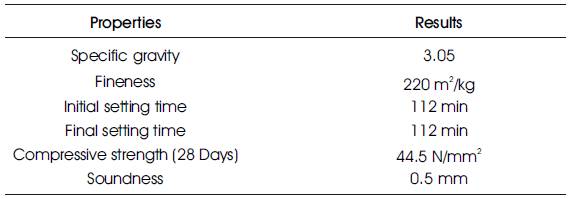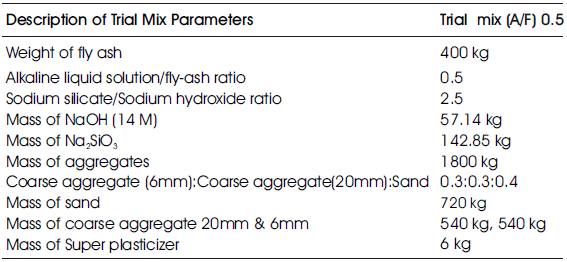
Table 1. Chemical Composition of Fly Ash Used
It is expected that in the near future, the civil engineering community will have to produce structures in harmony with the concept of sustainable development through the use of high-performance materials with low environmental impact that are produced at a reasonable cost. Geopolymer concrete provides one route toward this objective synthesized from the materials of geological origin or by product materials such as fly ash, which are rich in silicon and aluminum. But major disadvantage of Geo Polymer Concrete (GPC) is curing of this concrete is to be carried at elevated temperatures and this concrete is recommended for precast members because of temperature curing. This paper finds solution to overcome these problems in GPC by replacing fly ash with cement and the tests show encouraging results by which this new cement added GPC can be made as Eco-friendly construction material.
Emissions of CO2 from cement production is increasing at a much more rapid rate than all other industrial sources put together. As countries develop, they build infrastructure and housing that utilize abundant quantities of concrete. As global development increases, Portland cement manufacturers can be expected to exert an increasingly greater influence on governmental policies regulating CO2 emissions, a situation that needs to be corrected as soon as possible. By the year 2015, global CO2 emissions from the manufacture of Portland cement is expected to be 3,500 million tonnes annually on the other hand Coal-based thermal power installations in developing countries contribute major part of the total installed capacity for electricity generation. In order to meet the growing energy demand in these countries, coal-based thermal power generation is expected to play a dominant role in the future as well. As a consequence, a huge amount of fly ash (FA) is generated in thermal power plants, causing several disposal-related problems. Worldwide, the estimated annual production of coal ash in 1998 was more than 390 million tons. The main contributors for this amount are China and India, Only about 14 percent of this fly ash is utilized, while the rest was disposed in landfills (Malhotra 1999). By the year 2014, the amount of fly ash produced worldwide is estimated to be about 900 million tons annually (Malhotra 2002). In order to over come the above two problems civil engineering community will have to think of new construction materials with low environmental impact that are produced at a reasonable cost one such alternative is development of geopolymer concrete (GPC), synthesized from the materials of geological origin or by product materials such as fly ash, which are rich in silicon and aluminum. Geopolymeric concretes are the modern counterparts of ancient concretes, such as certain Roman concretes(Davidovits.1984), that have survived in extremely harsh environmental conditions for thousands of years. Geopolymeric concretes are actually man-made rock. The chemistry of geopolymerization is based on the same geosynthesis that occurred in nature to produce over 55% of the earth's crust. As such, when geopolymeric cement is mixed with natural rock aggregates, the resulting concrete retains the beauty and excellent properties of strong natural rock. Manufacturing geopolymeric cement generates five (5) times less CO2 than does the manufacture of Portland cement (Palomo, et.al. 1999). Any country that converts to the manufacture of geopolymeric cement/concrete would eliminate 80% of the emissions generated from the cement and aggregates industries. Newly developing countries that elect to utilize geopolymeric concrete could increase their construction rate five times without increasing present CO2 emissions (Davidovits.1994).
To date various research studies have been conducted by many of the researchers on the behavior of FA-based GPC in both fresh and hardened states showing advantages of GPC like one ton of low-calcium fly ash can be utilized to produce about 2.5 cubic meter of high quality geopolymer concrete and the bulk cost of chemicals needed to manufacture this concrete is cheaper than the bulk cost of one ton of Portland cement. Given the fact that fly ash is considered as a waste material, the low calcium fly ash-based geopolymer concrete is therefore cheaper than the Portland cement concrete. The superior properties of geopolymer concrete can further enhance the economic benefits. But only disadvantage in geopolymer concrete manufacturing is the process of geoploymerisation needs heat during reaction which limits the GPC applications to pre cast members only. However some research studies has been conducted so far to overcome this problem of heat curing by replacing flyash with (Lloyd & Rangan 2009) other geopolymeric materials, but in India the coal that is used by all thermal power stations generates the low lime flyash. Therefore, this research is targeted to investigate the viability of overcoming the curing problem in Low lime fly ash based GPC by replacing flyash with cement to draw attention of civil Engineers to use this new eco-friendly cement added GPC for in-situ concrete works also.
In this research study, Low-calcium fly ash obtained from Ramagundam Thermal Power Station (RTPS) in Andhra Pradesh is used as a source material than high calcium fly ash. The presence of calcium in high amount may interfere with the polymerization process and alter the microstructure (Gourley2003). Chemical composition of FA as determined by X Ray Fluorescence (XRF) analysis is shown in Table 1 and the fly-ash confirms to the various specifications of IS : 3812-1987.

Table 1. Chemical Composition of Fly Ash Used
In geopolymerization, alkaline solution plays an important role. The most common alkaline solution used in geopolymerisation is a combination of sodium hydroxide (NaOH) or potassium hydroxide (KOH) and sodium silicate (Na2SiO3) or potassium silicate (K2SiO3). In this study, a combination of sodium silicate and sodium hydroxide was chosen as the alkaline liquid. Sodium-based solutions were chosen because they are cheaper than Potassium-based solutions. The sodium hydroxide (NaOH) used in this study was in flake form and of 98% purity. The sodium silicate solution (Na2SiO3) used is available locally. The chemical composition of the solution is given in Table 2.

Table 2. Chemical Composition of Sodium Silicate Solution
Crushed coarse aggregates with nominal sizes of 6mm and 20mm maximum size obtained from the local crushing plants used in the present investigation had a particle density of 1.57 tonnes/cubic metre and specific gravity of 2.64. Fine sand was sourced from a local supplier, the sand has a specific gravity of 2.43, bulk density of 1.65 tonnes/cubic metre and fineness modulus of 2.27. The physical properties of aggregates were tested in accordance with IS : 2386 and care was taken that the aggregate surface was in Saturated Surface Dry (SSD) condition. In geopolymer concrete the necessity for SSD was to eliminate the absorption of the alkaline solution by the aggregates thus reducing the polymerization of the fly ash. Conversely the presence of excessive water may compromise the compressive strength of the geopolymer concrete. The preparation of aggregate to surface saturated dry condition is achieved by soaking the aggregate in water for 24 hours, draining, and air drying on trays to remove surface moisture.
As this research is targeted for GPC usage in in-situ concrete works, In order to achieve superior workability and required flowability of the fresh concrete a commercially available superplasticizer CONPLAST SP-430 is used in the mix and the dosage of the Super plasticizer is fixed to 1.5% of the mass of fly-ash (Hardjito D & Rangan B.V, 2005).
43-Grade ordinary Portland cement is used. The physical properties and composition of major compounds are shown in Table 3 and Table 4.

Table 3. Physical Properties of Cement used in the Mix

Table 4. Chemical Composition of the Cement
The IS 456:2000 recommends the minimum strength of concrete to be used in civil construction is M 20 and the nominal mix ratio suggested is 1:1.5:3, based on the previous works on low lime FA based GPC (Reddy et.al 2011) for achieving the target mean compressive strength of 26.56 N/mm2 the molarity of NaOH solution was fixed as 14M. For the present investigation fly ash in GPC is replaced with 10% of cement. Based on the curing conditions the GPC mixes are designated as
NGPC --Normal Geoploymer concrete with 0% cement cured @ 60oC
CGPC-T -- Cement added Geoploymer concrete with 10% cement cured @ 60oC
CGPC-W --Cement added Geoploymer concrete with 10% cement cured in water
Mix proportioning to obtain GPC was carried out using the absolute volume method. From the past literatures it is clear that the average density of fly ash-based geopolymer concrete is similar to that of OPC concrete (2400kg/m3). In the design of geopolymer concrete mix, coarse and fine aggregates together were taken as 75% of entire mixture by mass. This value is similar to that used in OPC concrete in which it will be in the range of 75 to 80% of the entire mixture by mass. Fine aggregate was taken as 40% of the total aggregates. Knowing the density of concrete, the combined mass of alkaline liquid and fly ash is arrived at. By assuming the ratios of alkaline liquid to fly ash as 0.5, mass of fly ash and mass of alkaline liquid was found out. To obtain mass of sodium hydroxide and sodium silicate solutions, the ratio of sodium silicate solution to sodium hydroxide solution was fixed as 2.5. For the present investigation, concentration of NaOH solution is fixed to 14M. No extra water is added other than the water used for the preparation of alkaline solutions and dosage of super plasticizer was added to the mix according to the workability desired. Using the above procedure the mix was designed and the mix proportions are given in Table 5.

Table5. Trial mix Proportions for 1m3 of Geopolymer Concrete for 14M NaOH Solution
For the present investigation Trial mix is fixed as shown in Table-5 and different trial mixes for A/F ratios of 0.5 and 0.6 are prepared with and with out cement by following procedure
Workability characteristic plays an important role for in situ concrete works. It is a main property that defines a mix is highly workable in attaining consolidation and specified hardened properties. As stated earlier, to accomplish the workability properties, for each mix slump test is carried out. The test results of workability properties are presented in Table 6. The results of the quantitative measurements and visual observations showed that on cement addition to GPC the slump was reduced. Both mixes had good flowability and there was no signs of bleeding as well as segregation.

Table 6. Workability of Geoploymer Concrete for 14M Concentration of NaOH
The compressive strength is one of the most note worthy properties of hardened concrete and is considered as the characteristic material value for the classification of concrete. In this study, compressive strength test was performed in accordance with IS codes using 2000 KN Digital Compression Testing Machine. A set of six cubes for each mix were tested for each presented value. The average compressive strength of the three mixes for different A/F ratios are presented in Tables 7 & 8. It is shown in Figure 1 for all mixes the compressive strength of concrete increases with the age of GPC. For cement added mixes (i.e Mix-CGPC-T& CGPC-W), the concrete samples cured in water is giving more strength compared to samples cured at 60oC.

Table 7. Compressive Strength of Geopolymer Concrete for A/F-0.5 & 14M NaOH

Table 8. Compressive Strength of Geopolymer Concrete for A/F-0.6 & 14M NaOH

Figure 1. Comparison between Compressive Strength of Geoploymer Concrete for A/F-0.5 & 14M NaOH Solution

Figure 2. Comparison between Compressive Strength of Geoploymer Concrete for A/F-0.6 & 14M NaOH Solution
In this experimental work, workability characteristics and compressive strength of cement added low-lime flyash based GPC are assessed. It was observed that it is possible to achieve in-situ GPC for Indian conditions. From the experimental results reported in this paper, the following conclusions are drawn.